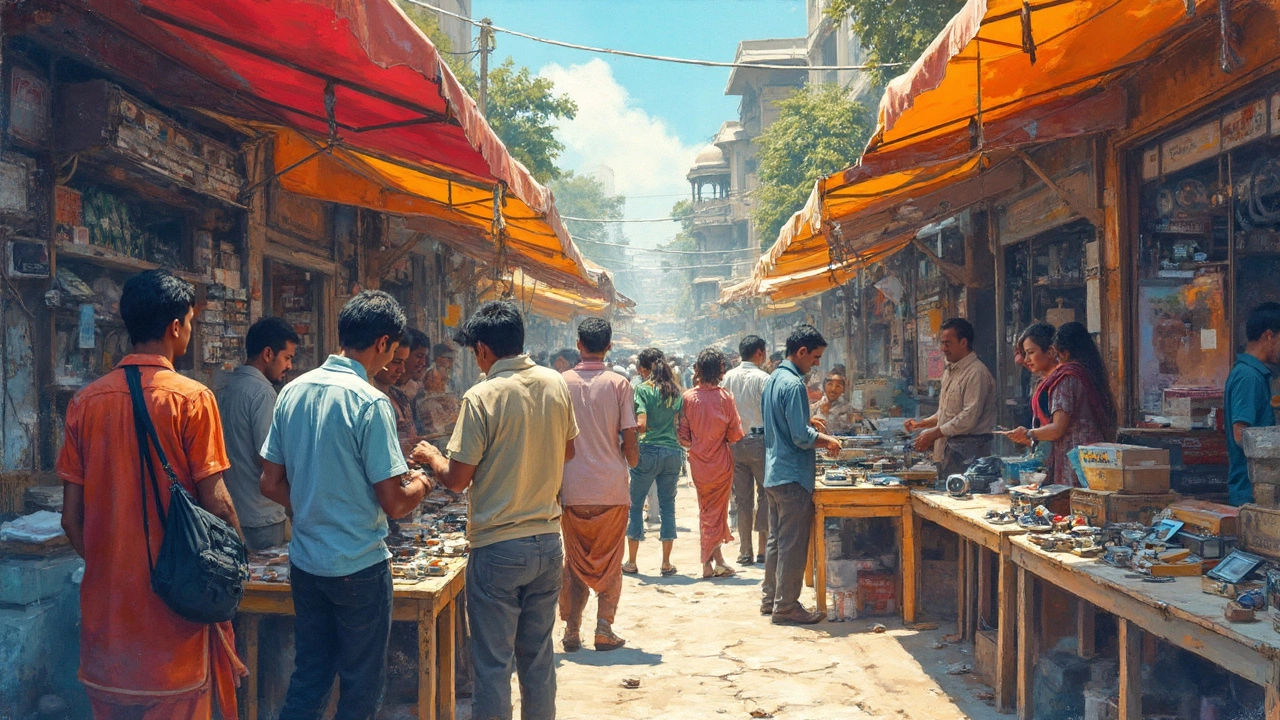So, you're wondering about India's voltage standards? With all the gadgets and devices we carry around, knowing whether India uses 110V or 220V can save you a whole lot of hassle. To cut to the chase—India operates on a 220V supply. It's the kind of thing that's no big deal until you find yourself with an incompatible device and no converter in sight!
Understanding these voltage standards is key for anyone planning to manufacture or even just use electronics in India. It's not just about plugging in your hairdryer or phone charger; it impacts everything from production logistics to personal convenience. But where did this 220V choice come from, and how does it affect what's being built or used? Let's dig a bit deeper and see how this choice shapes the electronics landscape there.
- India's Voltage Standards
- Why 220V? The History
- Impact on Electronics Manufacturing
- Tips for Travelers and Expats
- Future Outlook: Evolving Standards
India's Voltage Standards
Alright, let's get into the nitty-gritty of why India uses 220V. Just like many parts of the world, India sticks with the 220V-240V range for its electrical system. This means that almost all electrical outlets you'll find, whether in bustling cities or quiet rural spots, have this same voltage standard. The frequency in India is 50 Hz, which aligns with the systems in Asia and Europe.
This choice dates back to the colonial era. When the British were building infrastructure, they adopted the higher voltage system—partly because it was the norm in the UK and partly because it was cost-effective for transmitting electricity over larger areas with less power loss. Makes sense, right? You wouldn't want half of your energy wasting away before it even gets to the plug.
For anyone working in electronics manufacturing or planning to take their gadgets to India, it's crucial to confirm that devices are compatible with the 220V standard. Many modern electronics are designed to handle a range between 110V and 240V, but it's not a given for older models or specific industries. Always check those specifications before plugging in.
Here's a quick tip: If you're an expat or a tourist planning on staying a while, snagging a voltage converter can save you from frying your favorite devices. It's a simple device but a real lifesaver, ensuring your gadgets get the juice they need without any drama.
Why 220V? The History
Alright, let's tackle why India opted for 220V in the first place. It all goes back to the colonial era. When the British were setting up the infrastructure in India, they used the same standards as in the UK—hence the 220V and 50Hz frequency.
This choice was largely about efficiency. Higher voltage means less current is needed to do the same amount of work, and that reduces energy loss over power lines. It was a smart move, especially for a country as vast and spread out as India. If you've ever seen the sprawling fields and busy towns, you’ll know why keeping losses low is such a big deal.
The impact of choosing 220V has remained significant. It allowed India to adopt a setup that was already tried and tested in other parts of the world. It's not only a technical choice but also an economical one. The whole system of transformers, wirings, and appliances was built around this standard, making it deeply integrated into how things operate today.
Plus, having a similar system as prevalent in Europe meant that importing equipment and technology became smoother and relatively cheaper. While most of the Western Hemisphere, like the U.S. and Canada, uses 110V, aligning with 220V worked wonders for trade relations with Europe, which only helped in the growth of electronics manufacturing in India.

Impact on Electronics Manufacturing
The choice of a 220V power supply plays a crucial role in shaping the electronics manufacturing scene in India. First off, having 220V as a standard means that producers need to design appliances and gadgets that can handle this voltage. This affects everything from the internal circuitry to the materials used.
India's 220V system aligns with European standards, which is actually a strategic win for manufacturers looking to export Indian-made electronics to many parts of the world. It makes it easier to cater to larger markets without having to rethink product designs from scratch. On the flip side, it means any imported goods from countries with a 110V system need adaptors or modifications, adding an extra layer of complexity.
Now, let's talk about safety and efficiency. The 220V supply typically results in lower electric current for the same power level compared to 110V systems. That can mean fewer losses over long-distance transmission lines, which is crucial in a vast country like India where rural electrification is a big goal.
For India voltage manufacturers, staying abreast of safety regulations becomes key. With higher voltages, product safety and quality standards need stringent checks to prevent incidents. Adhering to these regulations isn't just about compliance—it's also about ensuring customer trust and reducing liability.
Let's break it down further with some nitty-gritty on market trends. The demand for electronics in India is booming, with smartphones, consumer goods, and appliances consistently in the spotlight. Companies that can quickly adapt their production lines to efficiently utilize the 220V infrastructure might find themselves with a competitive edge. The global pivot to more sustainable production methods also prompts local producers to consider eco-friendly materials and processes.
In short, understanding the electrical landscape in India isn't just a tech detail. It's a central pillar that influences design, production, and market strategy, playing a pivotal role in the success of electronics manufacturing in India.
Tips for Travelers and Expats
Traveling to or living in India? Grabbing plug adapters and voltage converters might not be top of mind until you fry your favorite gadget. With India operating on a 220V power supply, these tips might save your devices—and your sanity!
First things first, check the voltage requirements of your devices. Most modern laptops and phone chargers are dual voltage (100-240V), so they adjust themselves, but always double-check just to be safe. If your device isn’t dual voltage, you’ll need a voltage converter.
- Adapters Galore: India uses type D electrical outlets, so get yourself a few plug adapters to fit D-shaped sockets. You might find a universal adapter handy when hopping between countries.
- Stock Up on Converters: If you have devices that operate on 110V, don't skimp on a good quality converter. Cheaper ones might not handle the wattage of heavier appliances, causing damage.
- Buy Locally: Sometimes it's easier (and safer) to purchase small appliances locally. Things like hairdryers and kettles are affordable and easy to pick up in local markets.
If you're planning a longer stay, especially for work, consider investing in a power strip with surge protection. Power cuts and surges can be a thing in some areas. A table below shows some local voltage stats that can help you better prepare:
| Region | Typical Voltage Fluctuation |
|---|---|
| Mumbai | Stable, rare fluctuations |
| Delhi | Mild fluctuations in summer |
| Rural Areas | Frequent fluctuations |
I hope these little nuggets of wisdom help you breeze through using electronics in India without a hitch. It might seem daunting, but with the right gear and a bit of prep, you'll be more than ready to handle the 220V adventure.

Future Outlook: Evolving Standards
When it comes to the future of India's electrical standards, there's a lot on the horizon that's pretty exciting and crucial to know, especially if you're in the electronics manufacturing India business. While India is currently set at 220V, there's always room for evolution given the rapid advancements in technology and changing energy needs.
The government and industry players are increasingly aware of the prospects for adopting intelligent power systems and potentially even green energy solutions. This includes integrating more sustainable energy sources which might eventually affect how voltage standards are applied across the board.
There’s buzz around upgrading infrastructures to support more modern appliances and to align with global power standards. But these plans also depend a lot on technological feasibility and the economic landscape. Keeping pace with urban growth and technological advancements means India has to consider whether its current infrastructure can cope or needs an upgrade.
And hey, it’s not just about shifting voltage that matters. What’s really significant is the move to a more reliable power grid, improving electricity reach, and minimizing blackouts—all of which can have a big ripple effect on quality and manufacturing efficiency.
For those dealing with electronics on any level, keeping an ear to the ground regarding changes is crucial. New standards could mean a shift in production processes or a chance to tap into new opportunities as India’s power landscape evolves.
A side note for the data buffs out there: according to a 2024 report, India has invested upwards of $5 billion in infrastructure to enhance its overall energy efficiency, proving there's serious momentum in updating the grid.
If you're dealing with India voltage decisions or strategies, staying informed will give you an edge as the landscape continues to shift. It’s like being ahead in a game of chess, seeing the moves before they happen!










Write a comment